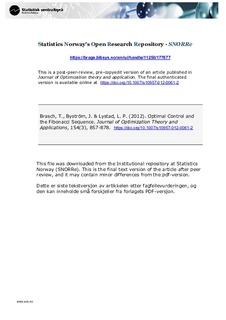| dc.contributor.author | Brasch, Thomas von | |
| dc.contributor.author | Byström, Johan | |
| dc.contributor.author | Lystad, Lars Petter | |
| dc.date.accessioned | 2019-01-14T15:05:22Z | |
| dc.date.available | 2019-01-14T15:05:22Z | |
| dc.date.issued | 2012-04-26 | |
| dc.identifier.citation | Brasch, T. von, Byström, J. & Lystad, L.P. Journal of Optimization Theory and Application (2012) 154: 857. https://doi.org/10.1007/s10957-012-0061-2 | nb_NO |
| dc.identifier.issn | 1573-2878 | |
| dc.identifier.uri | http://hdl.handle.net/11250/2580549 | |
| dc.description.abstract | We bridge mathematical number theory with optimal control and show that a generalised Fibonacci sequence enters the control function of finite-horizon dynamic optimisation problems with one state and one control variable. In particular, we show that the recursive expression describing the first-order approximation of the control function can be written in terms of a generalised Fibonacci sequence when restricting the final state to equal the steady-state of the system. Further, by deriving the solution to this sequence, we are able to write the first-order approximation of optimal control explicitly. Our procedure is illustrated in an example often referred to as the Brock–Mirman economic growth model. | nb_NO |
| dc.language.iso | eng | nb_NO |
| dc.publisher | Springer | nb_NO |
| dc.subject | Fibonacci sequence | nb_NO |
| dc.subject | Brock–Mirman model | nb_NO |
| dc.subject | Mathematical number theory | nb_NO |
| dc.subject | Optimal control | nb_NO |
| dc.title | Optimal control and the Fibonacci sequence | nb_NO |
| dc.type | Journal article | nb_NO |
| dc.type | Peer reviewed | nb_NO |
| dc.description.version | acceptedVersion | nb_NO |
| dc.rights.holder | © Springer Science+Business Media, LLC 2012 | nb_NO |
| dc.subject.nsi | VDP::Samfunnsvitenskap: 200::Økonomi: 210 | nb_NO |
| dc.source.pagenumber | 857-878 | nb_NO |
| dc.source.volume | 154 | nb_NO |
| dc.source.journal | Journal of Optimization Theory and Applications | nb_NO |
| dc.source.issue | 3 | nb_NO |
| dc.identifier.doi | https://doi.org/10.1007/s10957-012-0061-2 | |
